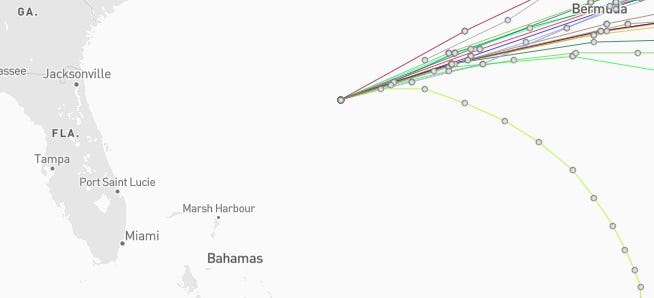Imelda became the Atlantic season’s fourth hurricane Sept. 30 and continues to strengthen as it takes aim at Bermuda and moves away from Florida and the United States, according to the National Hurricane Center.
Hurricane Imelda is forecast to bring hurricane-force winds, damaging waves and flash flooding to Bermuda late Wednesday, Oct. 1.
➤ Weather alerts via text: Sign up to get updates about current storms and weather events by location
Swells generated by Hurricane Imelda and Hurricane Humberto also continue to impact much of the U.S. east coast, including Florida. These swells are likely to cause life-threatening surf and rip current conditions.
Latest weather watches and warnings issued in Florida
No tropical storm or hurricane watches or warnings are in effect on land for Florida or the U.S.
A hurricane warning is in effect for Bermuda.
Storm tracker: Where is Hurricane Imelda going?
Special note on the NHC cone: The forecast track shows the most likely path of the center of the storm. It does not illustrate the full width of the storm or its impacts, and the center of the storm is likely to travel outside the cone up to 33% of the time.
What is the National Hurricane Center’s ‘cone of uncertainty’?
The cone you see from the National Hurricane Center shows a consensus based on models on where the center could be over the next several days, and the center of the storm is likely to travel outside the cone up to 33% of the time.
Track forecasts can be off by an average of 60 to 70 miles.
Impacts also can be felt sometimes hundreds of miles from the center of the storm, which is the case with both Hurricanes Imelda and Humberto.
Hurricane Imelda spaghetti models, path
Special note about spaghetti models: Illustrations include an array of forecast tools and models, and not all are created equal. The hurricane center uses only the top four or five highest performing models to help make its forecasts.
What impacts can Florida expect from Hurricane Imelda?
Swells generated by Hurricane Imelda and Hurricane Humberto also continue to impact much of the U.S. east coast, including Florida.
The National Weather Service said Florida can expect the following conditions to continue through the week:
-
Dangerous beach and boating conditions
-
Life-threatening rip currents
-
Rough surf with breakers of 5 to 12 feet.
-
Hazardous coastal and marine conditions.
-
Numerous showers, with risk of locally heavy rain and flooding near the coast. Coastal counties could see 1-3 inches of rain with up to 5 inches in some areas. Interior counties less than 1.5 inches.
-
Rough breaking surf of 6 to 9 feet, especially at time of high tide
-
Hazardous boating conditions with max seas of 7 to 9 feet nearshore and up to 12 feet offshore in the Gulf Stream
-
Hazardous marine and beach conditions
-
High risk for dangerous rip currents
-
Elevated surf conditions with surf heights of 7 to 9 feet
-
Seas of 7 to 10 feet in Atlantic waters will be hazardous for small craft
-
Rain chances increase Oct. 1, with scattered showers expected in the afternoon
Florida weather radar for Wednesday, Oct. 1, 2025, with Hurricane Imelda offshore

Excessive rainfall forecast across Florida
What storms are in the tropics right now?

This auto-updated graphic shows a map of all active storms in the Atlantic basin.
Can’t see the graphic? Open in a new browser.
Forecasters urge all residents to keep an eye on the tropics and to always be prepared
Officials regularly encourage Florida residents to prepare for storms before a hurricane is approaching, while shelves are fully stocked and you aren’t battling crowds all rushing to the store at the same time.
“It only takes one storm to make it an impactful year for your community,” the National Hurricane Center Miami posted on X.
➤ See list of emergency supplies you can now buy tax free
On Aug. 1, specific hurricane supplies became permanently tax-free in Florida, ranging from batteries to generators.
➤ Don’t have a hurricane supply kit? From the basics to the extras, here’s what you need
Here are some of the basics you should have:
-
Two-week supply of medications
-
A go-bag with essential supplies in case you need to leave quickly
-
Portable cellphone chargers
-
List of emergency phone numbers, including those for family members
-
Copy of your insurance policy
When does hurricane season end?
The Atlantic hurricane season runs from June 1 through Nov. 30.
Ninety-seven percent of tropical cyclone activity occurs during this time period, NOAA said.
The Atlantic basin includes the northern Atlantic Ocean, Caribbean Sea and the newly renamed Gulf of America, formerly the Gulf of Mexico.
Stay informed. Get weather alerts via text
What’s next?
We will update our tropical weather coverage daily.
Download your local site’s app to ensure you’re always connected to the news. And look for our special subscription offers here.
This article originally appeared on Palm Beach Post: Hurricane Imelda spaghetti models, path, storm tracker Florida impacts









